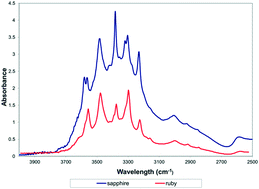The internal structure of hydrothermally grown leucosapphire crystals
Abstract
This study explores the fine structural details of the boundaries between the growth micro-sectors in a leucosapphire (pure corundum, α-Al2O3) crystal grown hydrothermally on a nonsingularly oriented (01![[1 with combining macron]](https://www.rsc.org/images/entities/char_0031_0304.gif)
![[2 with combining macron]](https://www.rsc.org/images/entities/char_0032_0304.gif) ) seed. Numerous lamellae along the basal planes of corundum formed on the boundaries of the growth micro-sectors; the thickness of the lamellae ranges from 10 to 30 nm with a length of up to 10 μm. They are composed of an aluminum oxyhydroxide phase, best approximated by the boehmite structure compressed along the c axis by 17% of the initial value of parameter c and stretched along the a and b axes by 12 and 6%, respectively, and therefore called boehmite′. Boehmite′ of the lamellae is epitaxially intergrown with the host leucosapphire (0001)C ‖ (020)B′. In some lamellae, boehmite′ undergoes a subsequent partial or full topotaxial transformation into corundum, in a twinned or identical orientation with respect to the leucosapphire host. The trigger for this retrograde transition is partial dehydration and reduction of local tensions around the lamellae. Comparison of the results with IR spectroscopic data on synthetic leucosapphire and ruby, grown under identical conditions, showed a complete analogy of sets of absorption lines in the stretch-oscillation region of OH groups. This paper analyses the differences in the internal structure of crystals of both varieties of corundum.
) seed. Numerous lamellae along the basal planes of corundum formed on the boundaries of the growth micro-sectors; the thickness of the lamellae ranges from 10 to 30 nm with a length of up to 10 μm. They are composed of an aluminum oxyhydroxide phase, best approximated by the boehmite structure compressed along the c axis by 17% of the initial value of parameter c and stretched along the a and b axes by 12 and 6%, respectively, and therefore called boehmite′. Boehmite′ of the lamellae is epitaxially intergrown with the host leucosapphire (0001)C ‖ (020)B′. In some lamellae, boehmite′ undergoes a subsequent partial or full topotaxial transformation into corundum, in a twinned or identical orientation with respect to the leucosapphire host. The trigger for this retrograde transition is partial dehydration and reduction of local tensions around the lamellae. Comparison of the results with IR spectroscopic data on synthetic leucosapphire and ruby, grown under identical conditions, showed a complete analogy of sets of absorption lines in the stretch-oscillation region of OH groups. This paper analyses the differences in the internal structure of crystals of both varieties of corundum.



 Please wait while we load your content...
Please wait while we load your content...